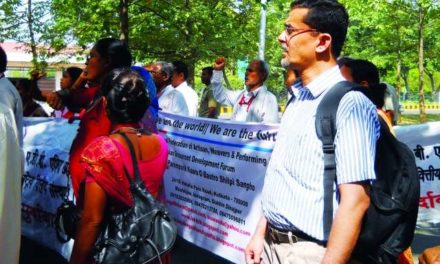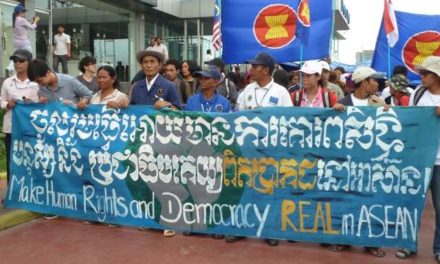by Nicola Bullard, Walden Bello, and Kamal Malhotra printed in The Nation Newspaper, 4 March 1998, Bangkok, Thailand
The decade-long US foreign economic agenda for Asia gained an opening in the financial crisis, and Washington was quick to use the IMF to exploit it, writes Nicola Bullard, Walden Bello, and Kamal Malhotra in the third of a four-part series
When the International Monetary Fund (IMF) came to Thailand last July, many sectors of Thai society welcomed it as a force that could discipline what was perceived as an irresponsible gang of politicians, businessmen and technocrats whose irresponsibility, profligacy and ineptitude had brought the country to its knees.
However, once the agreement with the IMF was announced in mid-August, doubts began to arise on the wisdom of the programme. The stabilisation part of the programme, many critics began to assert, was inappropriate. The Fund prescription basically demanded the maintenance of high interest rates to keep foreign capital from exiting the country and a sharp reduction in government expenditure in order for the government to achieve a budget surplus.
Both were expected to combine with the financial crisis not only to slow down the growth rate but to make it negative in 1998. The issue raised by both foreign and domestic critics was: this was not a crisis of the public sector but of the private sector, which had gone on a borrowing binge. In fact, the Thai government had been consistently running a government surplus until 1996.
So why squeeze the public sector, which had become the main element of a counter-cyclical process to prevent a deepening of recession as private investment slowed down? Wasn’t the avowed aim of both Thai and IMF authorities — the return of foreign capital — in fact likely to be thwarted by a deep recession? There was no clear answer to this except that foreign capital would somehow be assured by Thailand’s willingness to undertake an austerity programme.
As Harvard’s Jeffrey Sachs, the main proponent of this view put it: ”The region does not need wanton budget cutting, credit tightening and emergency bank closures. It needs stable or even slightly expansionary monetary and fiscal policies to counterbalance the decline in foreign loans.”
Sachs went on to claim that the Fund’s behaviour in fact worsened what was already a delicate situation in the fall of 1997: ”The IMF deepened the sense of panic not only because of its dire pronouncements but also because its proposed medicine — high interest rates, budget cuts and immediate bank closures — convinced the markets that Asia indeed was about to enter a severe contraction … Instead of dousing the fire, the IMF in effect screamed fire in the theatre. The scene was repeated in Indonesia and Korea in December. By then panic had spread to virtually all of East Asia.”
Moral hazard
Another concern that emerged had to do with the actual use of the US$17.2 billion rescue fund. The August 20 agreement stated that this sum would be devoted ”solely to help finance the balance of payments deficit and rebuild the official reserves of the Bank of Thailand”.
What this meant was that the funds could not be used to bail out local institutions. ”Financing the balance of payments deficit” was, however, a broad canopy that covered servicing the huge foreign debt of the Thai private sector, which in mid-1997 came to $72 billion (over half of this was short-term debt). The IMF-assembled funds provided an assurance that the government had the means to meet the immediate debt service commitments of the private sector, even as it sought to persuade the creditors to roll over or restructure their loans.
The rescue agreement thus fell right into the pattern of the IMF-US Mexican bailout in 1994 and the IMF structural agreements with indebted countries during the Third World debt crisis of the 1980s, in which public money from Northern taxpayers was formally handed over to indebted governments only to be recycled as debt service payments to commercial bank creditors.
Thus the Fund, critics charged, was encouraging ”moral hazard” or irresponsible lending because it assured lenders of a bailout if their decisions led to market penalities. Furthermore, to many, there was something fundamentally wrong about a process that imposed full market penalties for Thailand while exempting international private actors from them — indeed, socialising their losses.
As The Nation put it: ”The penalties imposed on foreign creditor banks which have lent to the Thai private sector must be precise and applied equally … Thailand and Thai companies may bear the brunt of the financial crisis but foreign banks must also share part of the cost because of some imprudent lending. It would be irresponsible to lay the blame entirely on Thailand.”
A third set of concerns had to do with the opening up of the economy to foreign economic interests. Particularly worrisome to many Thais was the IMF’s insistence that the country’s financial institutions, which had suffered big losses from the combination of non-performing loans and escalating foreign debt burdens owing to the precipitous drop of the baht, be recapitalised.
Mergers among Thai banks and financial institutions were one alternative, but one that was frowned on by the Fund. Infusing the banks with state resources in return for greater state ownership was, of course, a non-starter, giving the Fund’s own anti-statist leanings.
This left the Fund’s preferred option, which was to recapitalise mainly through capital infusions from foreign partners in return for granting the latter greater ownership rights. The legal ground for this was prepared by the National Assembly’s passing a decree allowing foreign entities to own up to 100 per cent of equity in Thai financial institutions.
This led to Japan’s Sanwa Bank purchasing a 10 per cent share in one of the country’s biggest banks, Siam Commercial Bank; negotiations by Citibank to acquire a 50.1 per cent ownership share in First Bangkok City Bank, and the Dutch-owned ABN-AMRO Bank’s acquisition of a majority stake in Bank of Asia.
The Fund also stepped up the pressure on the Chuan Leekpai government to liberalise the Alien Business Law to allow foreigners more liberal investment privileges in the non-financial sectors of the economy and to revise land ownership laws in order to allow foreigners to own land.
Of particular concern was what many saw as the one-to-one correspondence between the IMF approach and the US agenda not only in Thailand but in East Asia as a whole. It was no secret that US officials had long considered the complex of protectionism, mercantilism, industrial policy and activist state intervention in the economy that envelops most East and Southeast Asian economies as a system that handicapped US economic interests exporting or investing in Asia while unfairly assisting Asian firms in penetrating the US market.
In the case of Thailand and Southeast Asia, the assessment in Washington was that while they might have liberalised their capital accounts and financial sectors, they remained highly protected when it came to trade and were flirting dangerously with ”trade distorting” exercises in industrial policy like Malaysia’s national car project, the Proton Saga, or Indonesia’s drive to set up a passenger aircraft industry.
Prior to the crisis, however, US efforts to significantly move the Asian economies in the free-market direction desired by US corporations had brought meager results. Thus, a golden opportunity to push the decade-long US agenda in its foreign economic policy for East Asia opened up with the financial crisis, and Washington was quick to exploit it. US officials and former officials were not ones to conceal their designs.
As the Financial Times
noted in February 1998: ”Intriguingly, in recent weeks, US officials hinted to their domestic audience that they will use the opportunity provided by the crisis to force radical structural reform on other countries that would amount to what some critics see as an ‘Americanisation’ of the world economy.”
Summing up Washington’s strategic goal without having to use the euphemisms of his colleagues in the administration, Jeff Garten, undersecretary of commerce during President Bill Clinton’s first term, said: ”Most of these countries are going to go through a deep and dark tunnel. But on the other end there is going to be a significantly different Asia in which Americans have achieved much deeper market penetration, much greater access.”
With respect to Thailand, US Trade Representative Charlene Barshefsky, in hearings on why Washington should replenish the IMF’s coffers to the tune of $14.5 billion in February 1998, told the US Congress that in the Thai IMF programme, ”commitments to restructure public enterprises and accelerate privatisation of certain key sectors — including energy, transportation, utilities, and communications — which will enhance market-driven competition and deregulation [are expected] to create new business opportunities for US firms.”
Nicola Bullard is senior associate at Chulalongkorn University’s Focus on the Global South, a programme of policy research, analysis and action. Walden Bello and Kamal Malhotra are co-directors of Focus. The last part of the series will appear on Sunday.









